Right Roof = Right Requirements + Right Materials + Right Place
Concrete Decks
Concrete decks may be either structural or LWIC (lightweight insulating concrete). Structural concrete decks can be further divided into normal weight, lightweight structural, post-tensioned, and precast categories. While each of these are installed differently and have different structural properties, they are similar in moisture considerations and roof system attachment.
Concrete roof decks account for approximately 30 percent of roof decks. While concrete roof decks can be both mechanically attached and adhered, particular attention is needed when designing attachment to a concrete roof deck. Mechanical fastening is more labor intensive, and for structural concrete roof decks, X-ray or GPR is required so that the mechanical attachments do not penetrate the structural reinforcement. Adhered attachment methods are preferred for structural concrete decks. Ballasting roof materials is also an option, however, wind uplift of specific ballasted assemblies should be verified.
The inherent moisture in concrete decks is a concern. One of the main components in concrete is water, so the question of whether the concrete is ‘dry’ is often debated. A common misconception is that a concrete roof deck will be dry in 28 days, however, 28 days is the accepted time that concrete needs to obtain required compressive strength, not dryness. Additionally, as roof decks are exposed to the weather (rain, dewpoint condensation) during construction, water is reintroduced into the roof deck. The concern with a concrete deck that is not dry is that the inherent moisture in the deck is trapped within the vapor impermeable roofing assembly. The trapped moisture can lead to moisture accumulation, mold, and deterioration of roofing assemblies. For this reason, Class 1 vapor retarders installed on the deck level are recommended.
Trapped moisture within the concrete also has concerns over the lifespan on the roofing system. The repair of a concrete roof deck in a reroof scenario requires specialized contractors and equipment to properly repair the deteriorated locations. At locations of deterioration, the concrete is removed and new concrete is placed. While these repair methods are common, the concrete patches reintroduce moisture into the roof system.

Roof deck comparison chart.
Insulation
Rigid roof insulation is typically installed above the roof deck in most commercial assemblies. The most common insulation materials for commercial low slope roofs include polyisocyanurate (polyiso), expanded polystyrene (EPS), and extruded polystyrene (XPS). Other types such as mineral wool and vacuum insulated panels (VIP) are also available and installed in various roofing assemblies.
The selection of insulation should contrast among the various properties of the insulations; each of these types have their place in the market. Providing adequate insulation is critical in roofing assemblies for overall energy efficiency of the building. The higher the R-value, expressed per inch, the better the thermal performance of the insulation and its effectiveness at maintaining interior temperatures. One factor to consider for existing roofs where termination heights are limited, selecting a material with a higher R-value per inch can reduce the height of the insulation to help designers meet the height restrictions. Besides thermal resistance and a stable R-value, the insulation’s compatibility with adhesives, its component compatibility, water absorption, and compressive strength all need to be compared prior to selecting a material.
Polyiso has become the dominant insulation for commercial roofing, making up more than 70 percent of the market. Of the most common insulation types, polyiso offers the highest R-value per inch, meaning that polyiso does not require as much thickness as other types of rigid insulation to achieve the same insulation performance. Polyiso also offers good fire resistance as being a thermoset. Unlike polystyrene foams, it does not melt during a fire which can be hazardous for occupants and fire crews. Polyiso insulation is manufactured with a facer on each the top and bottom of the board. Two types of facers are available including glass fiber reinforced facers (GRF) and coated glass facers (CGF). GRF are made with organic fibers, and CGF are made with inorganic fibers; CGF further provides moisture protection and resistance to mold. Due to the facers, adhesives used in many adhered systems do not adversely affect polyiso, allowing it superior solvent compatibility when compared with polystyrene foams.
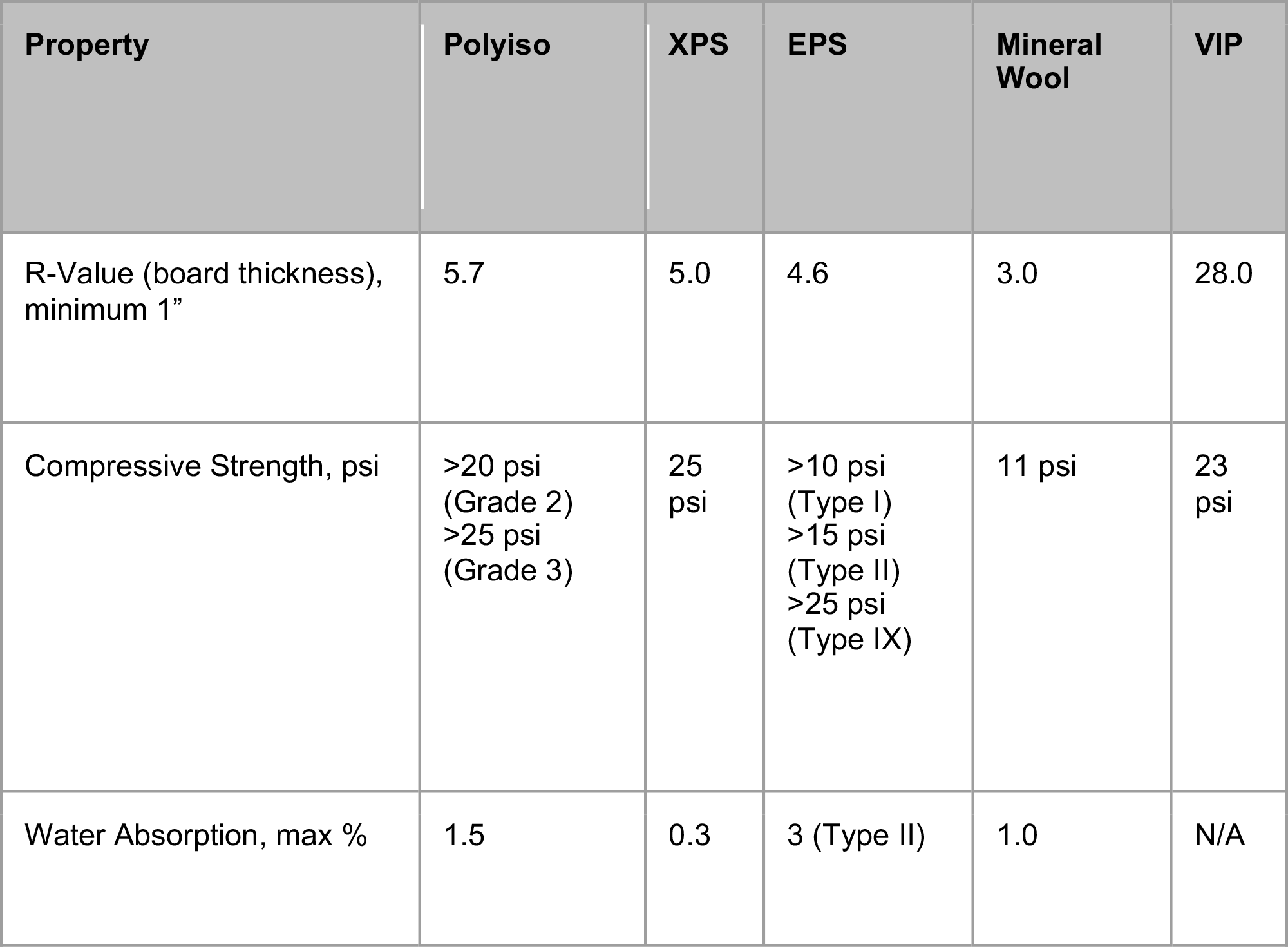
Insulation comparison chart.
Improper installation of the right insulation can impact overall roof performance. Insulation boards are required to be installed so that the joints are staggered and offset, and several layers of insulation should be installed rather than just one thick layer. Gaps between boards can decrease insulating ability by allowing thermal loss, as well as an increased condensation potential if air travels into and through the roof assembly. Air flowing between the boards also brings moisture, which if allowed to condense, can saturate the insulation boards. Wet insulation has an R-value of approximately zero, rendering wet insulation useless.
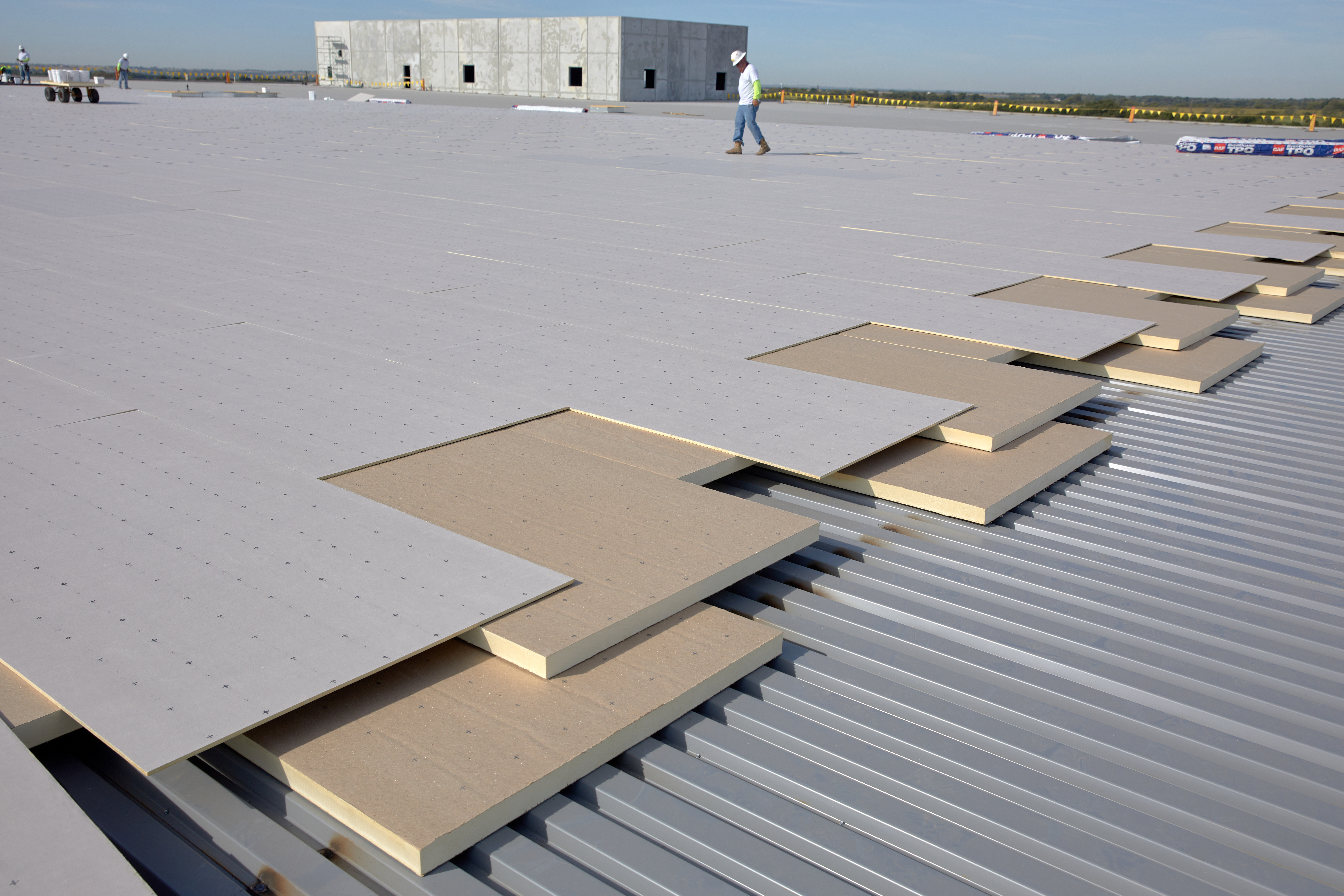
Staggering and offsetting insulation board joints on a steel deck.
Substrate Board/Roof Board and Vapor Retarder/Air Barrier
While not every roof assembly requires a dedicated vapor barrier or air barrier, it is important to know when one should be installed as well as recognize when it should not. Most often the roofing membrane functions as both the air barrier and the vapor barrier, however, controlling moisture is critical in roofing assemblies, and the use of a dedicated air or vapor barrier may assist in doing this. While both air barriers and vapor retarders can be used at the deck level to control air flow, only vapor retarders mitigate vapor transmission. A best practice is to install a vapor barrier on a concrete deck or over a building with high interior humidity where there is a higher potential for moisture vapor to enter into the roof assembly. For buildings with steel decks and spaces with high interior humidity, such as a natatorium, a substrate board installed on the steel deck will provide a sound substrate for the vapor retarder.
Incorrect placement of a vapor retarder can inadvertently trap moisture, and therefore, it can be a better design choice to not install a vapor retarder than to install it in the wrong configuration. The location and presence of a vapor retarder should be confirmed by hygrothermal analysis or a qualified design professional. Additionally, detailing for any air or vapor barrier is important as it must be continuous, across the roof and tied into the wall air or vapor barrier, without interruptions in order for it to function as intended.
Learn more about “Air Barriers, Vapor Retarders, and the roof in between”.
Coverboards
Coverboards are installed to prolong the life of the roof system, as they offer protection against fire, moisture, and heavy traffic. High density (HD) polyiso, glass mat, cementitious, and gypsum coverboards are the most common on the market today. Wood fiber and perlite are also available, although installed less frequently. Each has their advantages and considerations, including capability to resist hail and fire, and installation convenience. Coverboard selection also depends on the activities planned on the roof: for example, a higher compressive strength will be needed for solar or overburden installations, areas that experience larger hail, or high foot traffic zones. Coverboards also provide added protection against penetration, including tools dropped by service contractors. Coverboards not only increase the durability and resilience of a roof, but are considered a best practice to protect the entire roof assembly. Incorporating a coverboard into a roof assembly decreases overall lifecycle costs as replacement cycles are lengthened since the addition of the coverboard will mitigate damage from impact or foot traffic.
Coverboard selection may be influenced by ease of installation including weight of materials and ability to cut on-site. Wood fiber boards quickly became replaced in the market by newer technologies due to its heavyweight and the need for saws to cut. Most technologies only require the use of a utility knife. The weight of the boards also varies by material type. HD polyiso is very light and easy to cut, whereas glass mat gypsum is heavier, but must be used in areas where there is risk for larger hail stones.
Many insurance companies, including FM Global, may require a coverboard based on building location. FM Global has divided the contiguous US into three hail zones: Moderate Hail Zone, Severe Hail Zone, and Very Severe Hail. The hail zones are divided into the likelihood that a hail stone of a particular size is likely to occur in that zone. The selection of a coverboard will be determined by its ability to resist damage from hail of a particular size. For example, most coverboards available meet Severe Hail requirements, but only glass mat gypsum coverboards and plywood meet the restrictions of Very Severe Hail.
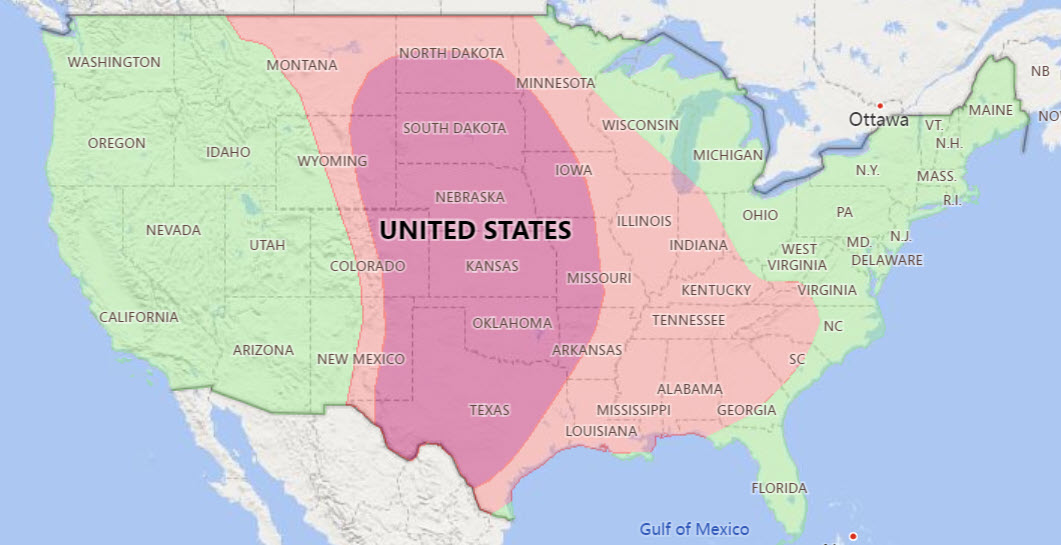
FM Global Hail zones where green is moderate hail (hail size ≤1.75”), pink is severe (hail size >1.75” and ≤2”), and dark pink is very severe hail (hail size >2”).
Each cover board has its place in the market. The roof assembly goals, including hail or resilience, should be reviewed in conjunction with the coverboard selection.
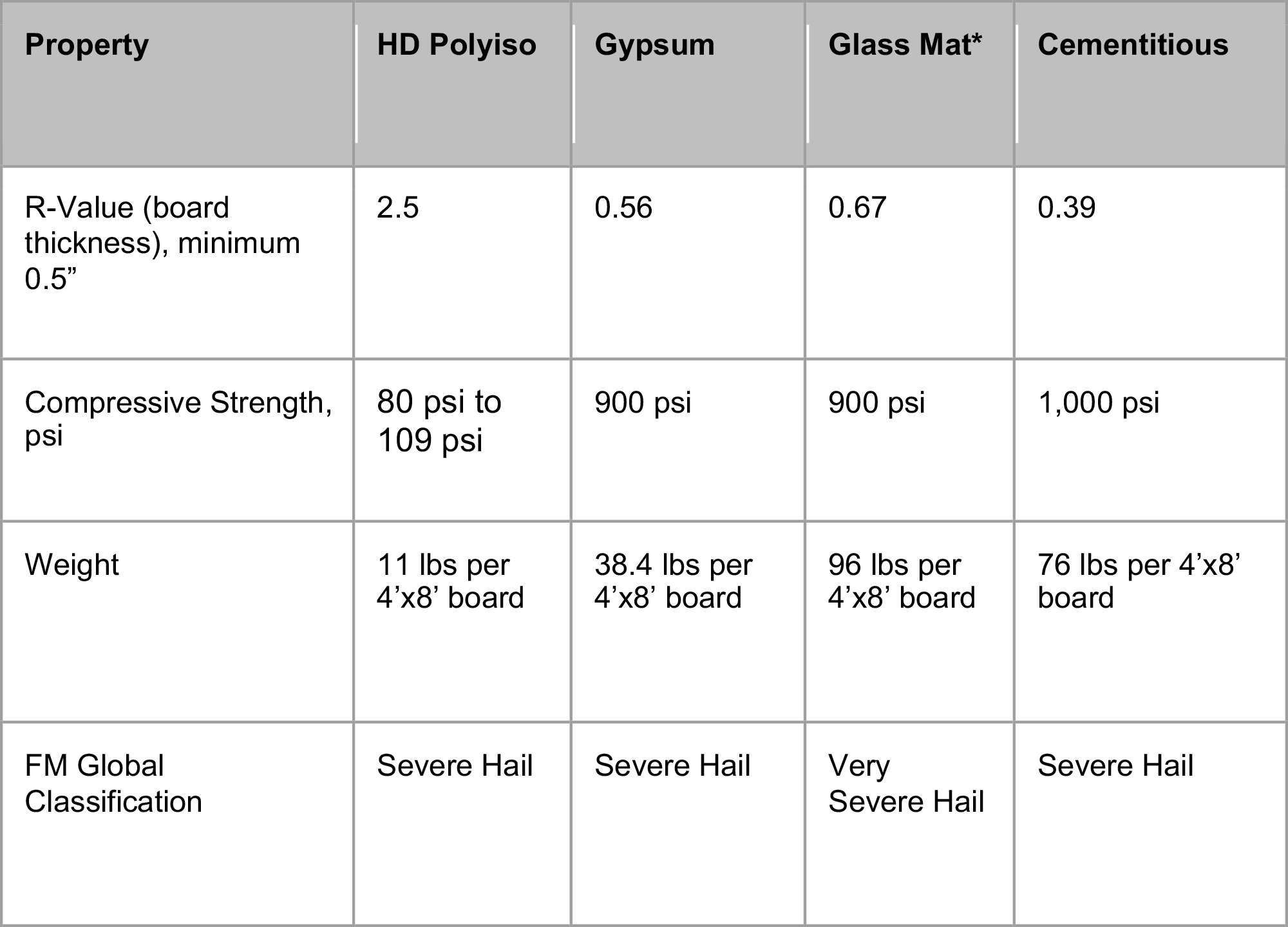
Coverboards compared at a glance. *Note that glass mat boards are typically ⅝ inches in thickness
Topping it Off: Selecting the Right Membrane and Attachment Method
Selection of the roof membrane, which acts as the waterproofing layer that protects the building, is critical. The membrane performance and roofing assembly configuration, including the location of the membrane in the assembly, must be considered. Selecting a membrane not adapted to the site specific challenges it will face can result in poor performance, costly repairs, or even replacement. Membrane performance is not only dependent on the associated roofing assembly materials, but also upon its design details and installation. Roof assembly selection and project specific design details down to the last termination and penetration detail should be provided to ensure the roof is installed in accordance with the contract documents.
Roofing Membrane Types
General roofing membrane types fall into these categories: asphaltic, single-ply, and liquid applied. Each roofing type has different chemical compositions, installation methods, and advantages; each of them has their place in the roofing industry.
Asphaltic roofing includes built-up roofing and modified bitumen. Both roofing types consist of several layers, or plies, of roofing, that are installed on the roof with various forms of asphalt.
Single-ply membranes are, as their name implies, a single layer of membrane roof material and are produced in rolls. Due to the nature of a single-ply roof, it can be rolled out more quickly than a traditional asphaltic system. However, due to the one layer, the membrane is not as robust as an asphaltic roof system with a granular surface. Single-ply membranes include EPDM, TPO, and PVC. The primary difference between the membranes is chemical composition, performance when exposed to chemicals at the roof surface, and treatment of the seams. Single-ply membranes are the most popular roofing membrane today due to their ease of installation and low cost compared to asphalt based materials. The chemical make-up of each of the membranes is different, and therefore, each of the membranes is preferable in different applications.
Liquid applied membranes are similar to a built-up roof where there are layers of liquid applied membrane and reinforcement installed directly on the roof. There are various chemical compositions available on the market.
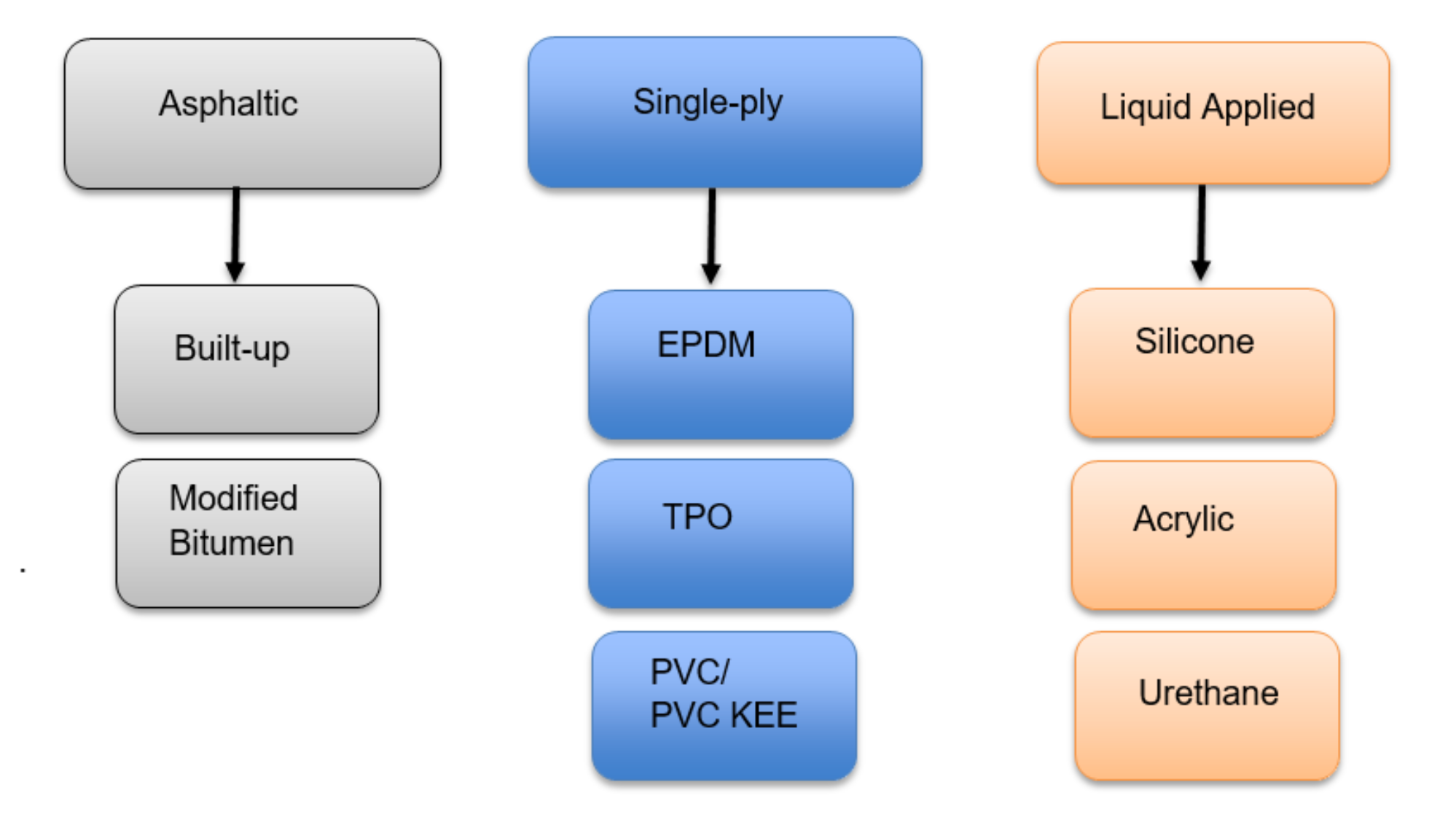
Roofing membrane types.
Built-up Roofing
As the original asphalt roof, built-up roofing dominated the low-slope roofing market for over 100 years but peaked in popularity during the 1970’s. Built-up roofing is labor intensive and requires special skills for installers, however, it is still installed today due to its robustness as a result of the many layers. Built-up roofing, or BUR, utilizes multiple layers of asphalt alternated with roofing ply sheets. Built-up roofs typically consist of four to five base plies of reinforcement and a cap ply where these layers are “built-up” across the roof deck. The asphalt is heated on the roof in a kettle, at temperatures upwards of 450 degrees Fahrenheit. Once the asphalt is melted, the plies are ‘mopped’ into place. After the plies are in place, an additional ply with UV protection is added on top of the base plies. The topmost layer, or cap ply, often consists of a ‘flood and gravel coat’ which is an additional layer of hot mopped asphalt with gravel cast into the melted asphalt. Gravel protects the asphalt from UV deterioration and also provides additional robustness to the base plies. One advantage of using hot asphalt is that it can be melted and installed in a wide range of temperatures, including very cold temperatures.
Today, BUR roofs have been largely replaced by modified bitumen roofs in part to the high labor and skill set required for these roofs. Additionally, some insurance companies do not allow for a hot kettle to be on the roof due to the fire hazard. The fumes of the melted asphalt can also be a concern in an existing building in a reroof scenario. However, BUR, with a completed thickness of 200 mils or more, is a robust roofing solution that is still used in many roof applications where robustness is a primary factor including at hospitals and schools.
Performance highlights:
- Redundancy to protect against moisture intrusion, damage (4-6 plies).
- Gravel surfacing provides excellent protection against damage and penetration.
- Low temperature installation.
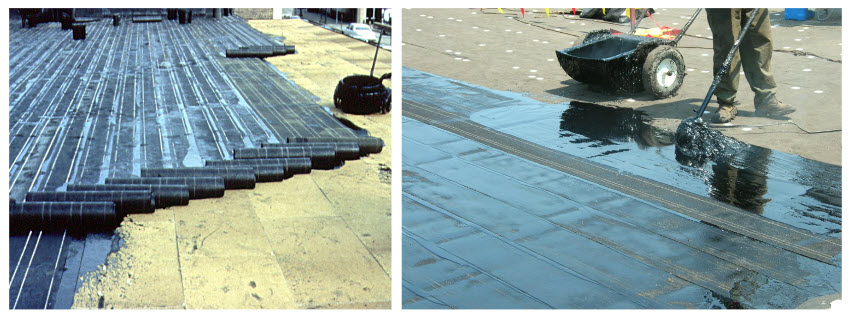
Modified bitumen installation, base plies being installed (left), hot mopping asphalt (right).









